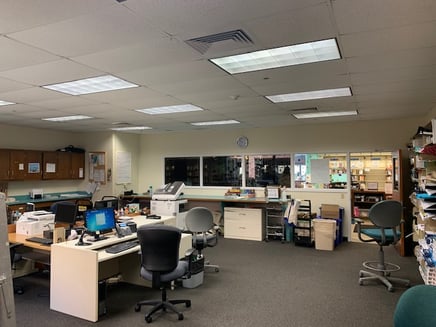Elevated or excessive indoor carbon dioxide (CO2) levels in a home, school, or office building can be hazardous. Humans produce and exhale carbon dioxide (CO2) as part of normal metabolic processes so occupancy of an indoor space will increase CO2 levels naturally. The CO2 build-up in a built environment such as a building, when humans occupy said space can be detrimental to human health. A common byproduct of elevated CO2 levels in humans is a feeling of tiredness, lack of focus, decreased cognitive skills, and even a sick or nausea feeling. Many people will typically feel this way after a large meal, but the timing of these systems and meals can rule out a full stomach and point to an indoor air quality issue. In short, elevated CO2 levels are not a health benefit.

What are acceptable CO2 levels?
CO2 levels will vary from outdoor to indoor, the rub is what is considered a high CO2 level.
In a perfect world indoor CO2 levels will be comparable to exterior levels.
Public Employees Occupational Safety and Health (PEOSH) standards or the American Society of Heating, Refrigeration and Air Conditioning Engineers (ASHRAE) standards both use a standard of below 1,000 parts per million (ppm) as a guideline for acceptable indoor air quality in buildings.
Many professionals evaluating indoor air quality relative to CO2 utilize the 1000 ppm standard. For comparison, an outdoor typical CO2 level will be around 400 to 500 ppm.
That said an indoor CO2 level of 700 and 800 ppm are baselines commonly used as markers for good indoor air quality. Not unlike mold indoor air quality evaluations, you do not want indoor levels to be excessively above outdoor air quality standards. For mold, it is common to flag an indoor issue if spores are 10% higher inside as compared to outdoor levels. Regarding CO2 excessive indoor levels have a higher variance.
What is considered a Safe CO2 Level Indoors?
Safe, Organic and New & Improved have varying meanings and interpretations. Safe CO2 levels can mean “best”, “not good”, “bad” or “potentially harmful.” Since we as humans manufacture CO2, levels can spike in a crowded room.
Best Indoor CO2 Levels: The best CO2 levels indoors are levels that match outdoor levels. Using 400 ppm as an outdoor baseline, levels at 400 would be considered best. Now we recently tested outdoor CO2 levels and came up with 500 ppm and used that number for indoor comparison. The point being levels can vary from acceptable averages. The industry using the 400 ppm (outdoor CO2 concentration) level, sets a threshold of CO2 being no more than 700 ppm above outdoor air. This bumps the 1000 ppm standard to 1,100 or 1200 ppm with a 500 ppm outside level.
Good CO2 Indoor Air Quality: CO2 levels below 800 ppm.
Acceptable C02 Levels: CO2 levels below 1,000 ppm are generally considered acceptable for most indoor environments.
How do I know if I have a CO2 problem? Have an indoor air quality assessment performed.
Our office fields many calls about indoor air quality and well over 75% of the complaints come from suspect mold. When we do an indoor air quality evaluation and test for mold and find normal indoor fungal ecology, we start talking about CO2 and other “suspects”, and blank stares ensue.
Mold and even CO2 are not always the smoking gun, meaning CO2 levels alone do not determine overall indoor air quality. Other pollutants, including volatile organic compounds (VOCs), particulate matter, cleaners and other chemical contaminants stored or used indoors can contribute to and degrade indoor air quality.
To maintain acceptable CO2 levels in buildings, proper ventilation systems and practices are mission-critical. Indoor CO2 concentrations are a combination of outdoor CO2, indoor breathing and the ventilation rate of the building (the HVAC is the lungs of the building). As buildings and homes become more energy-efficient and airtight, this means we have less fresh air and an increase in CO2.
Couple that with the fact that most all ventilation systems recycle indoor air to conserve energy, essentially moving the contaminated air around rather than cycling in new air. This results in high CO2 concentrations and poor indoor air quality. We thought that due to covid there would be an increase in upgrades to HVAC systems that would increase the intake of outside (fresh air) which helps with indoor air quality.
Air Quality Issues? Call the Experts
888-301-1050

